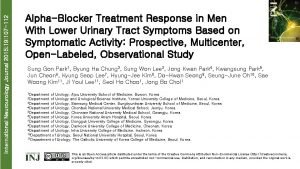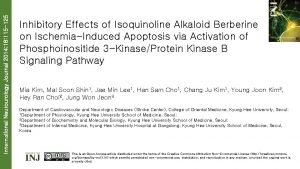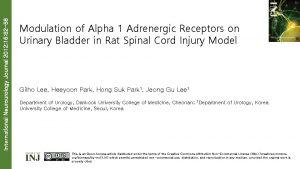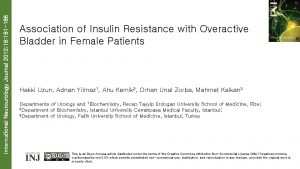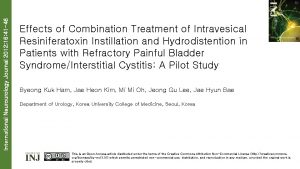International Neurourology Journal 2012 16 107 115 Characterization








- Slides: 8

International Neurourology Journal 2012; 16: 107 -115 Characterization of Bladder Selectivity of Antimuscarinic Agents on the Basis of In Vivo Drug-Receptor Binding Shizuo Yamada, Shiori Kuraoka, Ayaka Osano, Yoshihiko Ito Department of Pharmacokinetics and Pharmacodynamics, School of Pharmaceutical Sciences, University of Shizuoka, Japan This is an Open Access article distributed under the terms of the Creative Commons Attribution Non-Commercial License (http: //creativecommons. org/licenses/by-nc/3. 0/) which permits unrestricted non-commercial use, distribution, and reproduction in any medium, provided the original work is properly cited.

International Neurourology Journal 2012; 16: 107 -115 • The in vivo muscarinic receptor binding of antimuscarinic agents (oxybutynin, solifenacin, tolterodine, and imidafenacin) used to treat urinary dysfunction in patients with overactive bladder is reviewed. • Transdermal administration of oxybutynin in rats leads to significant binding of muscarinic receptors in the bladder without long-term binding in the submaxillary gland the abolishment of salivation evoked by oral oxybutynin. • Oral solifenacin shows significant and long-lasting binding to muscarinic receptors in mouse tissues expressing the M 3 subtype. Oral tolterodine binds more selectively to muscarinic receptors in the bladder than in the submaxillary gland in mice. The muscarinic receptor binding of oral imidafenacin in rats is more selective and longer-lasting in the bladder than in other tissues such as the submaxillary gland, heart, colon, lung, and brain, suggesting preferential muscarinic receptor binding in the bladder.

International Neurourology Journal 2012; 16: 107 -115 • In vivo quantitative autoradiography with (+)N-[11 C]methyl-3 -piperidyl benzilate in rats shows significant occupancy of brain muscarinic receptors with the intravenous injection of oxybutynin, solifenacin, and tolterodine. • The estimated in vivo selectivity in brain is significantly greater for solifenacin and tolterodine than for oxybutynin. Imidafenacin occupies few brain muscarinic receptors. • Similar findings for oral oxybutynin were observed with positron emission tomography in conscious rhesus monkeys with a significant disturbance of shortterm memory. • The newer generation of antimuscarinic agents may be advantageous in terms of bladder selectivity after systemic administration.

International Neurourology Journal 2012; 16: 107 -115 Fig. 1. Schematic representation of in vivo drug-receptor binding in relation to pharmacokinetics and pharmacodynamics.

International Neurourology Journal 2012; 16: 107 -115

International Neurourology Journal 2012; 16: 107 -115 Fig. 2. Serum and tissue (bladder, submaxillary gland) concentrations of imidafenacin (A) and muscarinic receptor binding activity (increase in the dissociation constant [Kd] for specific [3 H] N-methylscopolamine binding) in the bladder and submaxillary gland (B) of rats at 1 to 12 hours after the oral administration of imidafenacin (2. 0 mg, 6. 26 mol/kg). Significantly different from the control value (Con): a)P<0. 05. b)P<0. 01. (modified from Yamada S, et al. J Pharmacol Exp Ther 2011; 336: 365 -71, with permission of High. Wire / Stanford University) [45].

International Neurourology Journal 2012; 16: 107 -115

International Neurourology Journal 2012; 16: 107 -115 Fig. 3. (A) Typical positron emission tomography (PET) images fused with computed tomography images in the brain regions of rats that received intravenous injection of (+)N-[11 C]methyl-3 -piperidyl benzilate ([11 C](+)3 -MPB). The images were generated by summation of image data from 40 to 60 minutes after [11 C](+)3 -MPB injection. Each coronal section was different at 2. 1 -mm intervals. Upper left section, frontal lobe region; lower right section, cerebellum region. Third section in the upper panel was Bregma. (B) Effects of different doses of oxybutynin, darifenacin, and imidafenacin on PET images of [11 C](+)3 -MPB in the rat brain. Rats received intravenous injection of agents 10 minutes before the [11 C](+)3 -MPB injection. Each section represents the typical one of the Bregma -2. 1 mm region (fourth section in the upper panel in A). (modified from Yoshida A, et al. Life Sci 2010; 87: 175 -80, with permission of Elsevier) [64].









